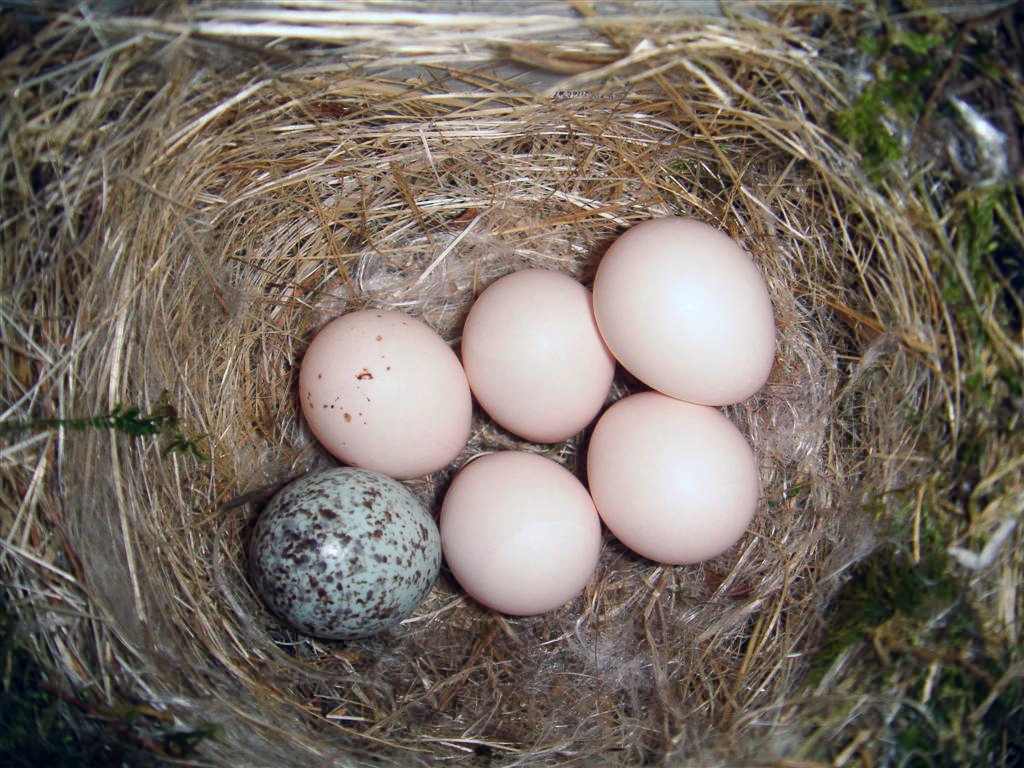The Birds that Sing for Their Supper

Five of the eggs pictured above belong together; one of those eggs just isn’t the same. And the difference is more than just shell-deep. The five similar eggs belong to a species known as the eastern phoebe, a common type in North and Central America. The other one is the egg of a brown-headed cowbird, which lives in the same general area — but wasn’t invited into the nest.
The reason the odd-egg-out? The brown-headed cowbird is a “brood parasitic” species, which means that it relies on another species to raise its young. Specifically, birds like the brown-headed cowbird lay their eggs in the nests of other birds, allowing the mother of the other eggs to do all the work, from incubating the eggs to feeding the young babies. In the case of the cowbird, it ensures that its egg stays in by retaliating if it is removed — one report likened the practice to “mafia-like behavior” — but otherwise leaves the host’s eggs alone.
But other brood parasite and host relationships aren’t as peaceful. Take the battle between the Horsfield’s bronze cuckoo and superb fairy wren in Australia — it’s a war, one that’s evolved to the point of secret codes and code breaking.
The cuckoo is the brood parasitic species here, laying eggs in the nests of the fairy wren. The visible differences between the two eggs aren’t nearly as stark as the in the nest depicted above — as Wikipedia explains, “the superb fairy wren will not reject the cuckoo’s egg, [because] fairy wrens make oval dome nests that can be dark inside, meaning it is harder for the fairy wren to distinguish between their own egg and the host’s egg.” Further, Wikipedia notes, “the mimicry in eggs from the Horsfield’s bronze-cuckoo have evolved over time and are hard to distinguish besides their slight elongation and glossier finish.” So there’s very little chance that the mother bird of the superb fairy wrens can visibly pick out the interloper.
To make matters worse for the fairy wrens, the mom may not even have the chance to look. While the Horsfield’s bronze cuckoo only lays one egg in a host’s nest (and removes a legitimate egg to make room), that’s only the beginning of the battle. Wikipedia also notes that the cuckoo egg hatches “two days before the host egg, ejecting other eggs in the nests within two days of hatching, leaving the cuckoo the sole chick.” If the mother cuckoo gets her egg into the fairy wren’s nest early enough, the only egg to survive the ordeal won’t be a fairy wren at all.
So the fairy wren fights back — by singing a special code to their unborn children.
The fairy wren has an incentive to not feed the baby cuckoo — that cuckoo (or its mate) is going to make a baby which is programmed to slaughter the fairy wren’s egg-encased grandchildren. So it comes up with a way to identify the right birds, thereby allowing it to ignore the cuckoo. Discovery Magazine passes along the findings of Diane Colombelli-Negrel, a professor of biological sciences from Australia’s Flinders University:
[Fairy wren] mothers sing a special tune to their eggs before they’ve hatched. This “incubation call” contains a special note that acts like a familial password. The embryonic chicks learn it, and when they hatch, they incorporate it into their begging calls. Horsfield’s bronze-cuckoos lay their eggs too late in the breeding cycle for their chicks to pick up the same notes. They can’t learn the password in time, and their identities can be [determined by the fairy wren mother].
If the baby bird, in the words of National Geographic, “doesn’t’ know the secret password,” the mother fairy wren will “abandon it, flying off to start a new nest and a new family somewhere else.” Per a 2003 study, about 40% of superb fairy wren nests containing only a Horsfield’s bronze cuckoo end up abandoned by the mother fairy wren. And that will likely continue — until the cuckoo evolves a song of its own which can fool its adversary. (And per many of the above-linked reports, that’s actually what’s starting to happen.) So expect this war of the nest to go on for a while more.
Bonus Fact: In 2013, a nationwide survey of 8,000 Australian bird lovers aimed to figure out which species of bird was the country’s most popular. The winner? The superb fairy wren! But no, the song of the female (and her babies) wasn’t the reason why. The visual appeal of the males and the, uh, friendliness of both genders is what carried the day, per the Guardian: “The males of the species, which are colored a vibrant blue, have been dubbed the ‘least faithful birds in the world’ owing to their rampant promiscuity. Female birds have been observed being courted by 13 males in a half-hour period.”
From the Archives: Defiled Eggs: Another war of the birds.
Take the Quiz: Name the bird from its non-bird definition.
Related: If you’re going to war, and you’re a bird (or fighting pigs), one of these may help.
